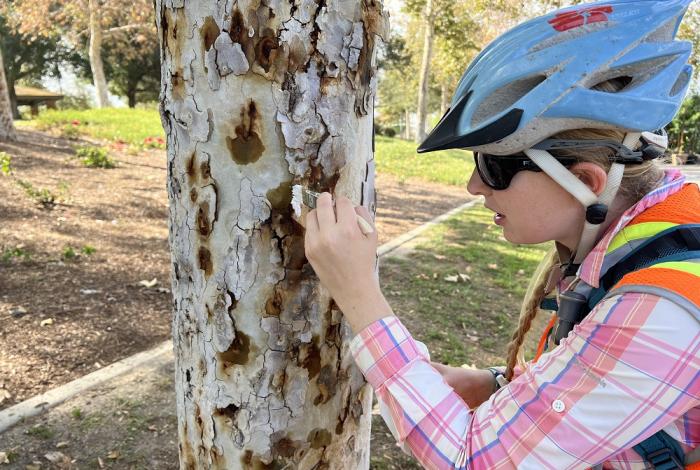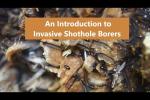Roots & Wings Online
- Homepage
- Communications
- Roots and Wings
- Roots and Wings Online
- Invasive Shothole Borer Beetle Threat...
Invasive Shothole Borer Beetle Threatens Tree Health
12/02/2022
LARMAC Collaborates with University to Save Trees throughout Ladera Ranch.
Ladera Ranch has an invasive pest, the Invasive Shothole Borer Beetle (ISHB) that is threatening the health of trees throughout the community. Since the ISHB beetle is not native to Southern California, it does not have a natural predator. This makes it extremely concerning since the beetle can reproduce quickly and given the extensive damage it can do to the local ecosystem in a relatively short time.
The invasive beetle bores into a tree and creates a series of galleries to lay its eggs in and in turn, grows Fusarium fungus, which the larvae feed on. This causes a disruption in water transport within the tree, which results in limbs becoming brittle and eventually death. As the tree limbs die and cause the tree to become dried out, they contribute to the wildfire hazard. Trees that are susceptible to this pest are the Sycamore, Cottonwood, Willow, Valley Oak, Engelmann Oak, White Alder, and Box Elder species.
Ladera Ranch Maintenance Corporation (LARMAC) is working diligently with OCFA, the University of California Cooperative Extension (UCCE), and leading experts in invasive tree pests, to address the infested trees in Ladera Ranch. Additionally, it is taking advantage of available grant funding in its effort to mitigate ISHB and save as many trees as possible in the community.
Through the California Department of Forestry and Fire Protection (CAL FIRE), the Orange County Fire Authority (OCFA) was awarded $5.4 million dollars to fund its ORC Invasive Tree Pest Mitigation and Fuels Reduction grant project to address the escalating problem of invasive tree pests in Orange County, reduce fuel loads from dead/dying trees, and reduce greenhouse gas emissions from increased wildfire activity and tree loss as a result of invasive pests.*
OCFA has contracted with UCCE to conduct tree surveys and provide treatment recommendations to save low to moderately-infested trees and remove severely-infested trees. UCCE researchers are actively looking for ways to control the beetle and the resulting fungal disease that often leads to tree death. The expenses related to surveys, treatment, and removal are being covered by the CAL FIRE Wildfire Prevention grant awarded to OCFA.*
To date, UCCE has surveyed over 1,800 trees at Cox Sports Park and along the Sienna Botanica. The recommendation is for the removal of 64 dead trees, some of which have already been removed, and 172 severely infested trees, also known as amplifier trees; the treatment of 371 moderately infected; and management of 1,068 trees with low levels of infestation. Treatments will vary and will be part of a UCCE research trial. LARMAC is in the process of reviewing the 172 trees identified as amplifier trees to verify that the trees should be removed instead of receiving aggressive treatment. The hope is that the trees with low levels of infestation will overcome the infestation with treatment and removal of the sources of infestation (amplifier trees).
For updates on this project, visit LaderaLife.com (see ‘Your HOA at Work’).
*The ORC Invasive Tree Pest Mitigation and Fuels Reduction grant project is part of California Climate Investments, a statewide program that puts billions of cap-and-trade dollars to work reducing greenhouse gas emissions, strengthening the economy, and improving public health and the environment – particularly in disadvantaged communities. It encompasses all Orange County State Responsibility Area (SRA) lands plus the SRA-Threat buffer zone.
UPDATE: September 8, 2023
Pest Control: Invasive Shot Hole Borer Tree Survey and Treatment
As part of a grant program with Orange County Fire Authority (OCFA) to address trees infested with Invasive Shot Hole Borer (ISHB), UC Cooperative Extension (UCCE) has completed the initial phase of surveying LARMAC's Sycamore trees. The survey is aimed at identifying those trees that are infested with ISHB and either treating or removing those that are highly infested.
LARMAC has the final say regarding whether a tree will be treated or removed. The grant will cover all associated costs related to treatment and removal. After the removal of the trees, LARMAC will evaluate the various areas to formulate a plan for replacement trees.
Updated results on the tree survey:
UCCE surveyed more than 1,800 trees and found that the majority of the sycamores are infested with ISHB. The findings are listed below. Note - The exact numbers may change pending a final walk and review of the infested trees.
- Recommend removal of 172 amplifier (severely infested) trees
- Treatment of 371 Moderately heavily infested trees (the type of treatment will vary)
- Management of 1,068 trees with low levels of infestation (some of these will be treated)
Update as of September 7, 2023:
- OCFA recently awarded the Phase 1 contracts to S&H Tree Landscaping & Arborist Services and RPW, Services Inc. S&H Tree Landscaping & Arborist Services is tentatively scheduled to start the tree removal portion of the project on Wednesday, September 13. Phase 1 includes trees located at Cox Sports Park, along Crown Valley, and in areas throughout the Oak Knoll Village. The project is estimated to take 3-4 days. Once the removals are complete, and at the direction of UCCE, RPW Services, Inc. will begin treatment on the infested trees in the same areas.
Resources:
Invasive Shot Hole Borers and Fusarium Dieback: A Devastating Threat to California Trees
Polyphagus Shot Hole Borer: A New and Important Beetle/Fungal Complex of Landscape Trees




